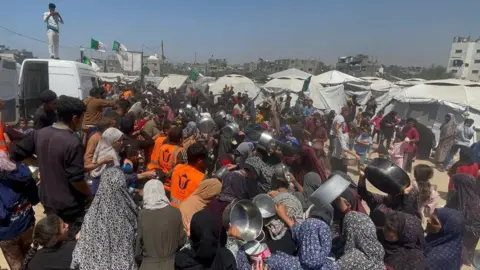The ongoing humanitarian situation in Gaza remains dire, as the United States has confirmed its plans for coordinating aid delivery through private firms amidst increasing concerns from the United Nations. With the Israeli blockade extending into a third month, the urgency for effective aid mechanisms is more pronounced than ever. The US approach aims to mitigate the risk of aid diversion by Hamas, with the US ambassador to Israel, Mike Huckabee, stating that “distribution centres” secured by private security contractors would provide initial aid to up to a million individuals.
Despite the proposed system, Huckabee clarified that Israeli forces would not partake in the actual delivery process, although they would provide perimeter security around the distribution centres. This initiative has been met with resistance from UN agencies, which have expressed their unwillingness to cooperate with a plan that they perceive as potentially weaponizing humanitarian relief. Jens Laerke, spokesperson for the UN’s Office for the Coordination of Humanitarian Affairs (OCHA), asserted that the UN’s integrity and principles are non-negotiable, emphasizing that they would only engage in efforts aligning with humanitarian norms.
The implications of Israel’s blockade have been devastating. Reports indicate that since early March, the flow of essential supplies—including food, medicine, and fuel—has been halted, resulting in acute humanitarian distress for Gaza’s 2.1 million residents. In a particularly concerning note, OCHA revealed that a third of Gaza’s community kitchens, which serve as vital lifelines for many families, have recently been forced to close due to critical shortages. The World Central Kitchen, a well-known US charity, reported it had to cease operations when it ran out of food supplies, demonstrating the depth of the crisis.
The prices of essential commodities have seen exponential increases, with basic items becoming unaffordable for most Gazans. For instance, the cost of a 25kg bag of flour skyrocketed to $415, a staggering increase from pre-blockade prices. This rise in food costs exacerbates the suffering and highlights the urgent need for humanitarian assistance.
The overarching strategy of the US and Israeli forces is to sideline Hamas’ influence by implementing a new structure for distributing aid. Their approach would shift responsibility to a newly created organization, the Gaza Humanitarian Foundation (GHF), aimed at ensuring that aid reaches those genuinely in need while avoiding Hamas interference. However, critics, including UNICEF, have raised alarms. They argue that the conditions under which aid would be distributed could exacerbate the suffering of the most vulnerable populations, particularly children and the elderly who would struggle to access aid in militarized zones.
A key element of the proposed system involves setting up distribution hubs within Gaza, but with significant concerns about how accessible these will truly be for the populace. Reports indicate that only a limited number of aid vehicles would be permitted to enter daily, far below the necessary threshold to meet the crisis’s demands. The UN and affiliated agencies have reiterated their preparedness to provide assistance if they could secure passage for their supplies, which remain stockpiled at border crossings awaiting approval.
By moving forward with this plan, the US aims to navigate the complexities of aid relief within a conflict zone while maintaining pressure on Hamas. However, heightened skepticism surrounds the effectiveness and ethical implications of utilizing private firms and militarized security in humanitarian initiatives. The failures experienced in previous aid distributions, such as reported looting issues, inform current debates about future strategies.
As the situation progresses, the international community watches closely, recognizing that the implications of these developments may extend beyond Gaza. Aid systems, conflict dynamics, and the moral obligations of humanitarian support are all entwined, and any misstep could significantly alter the landscape for future humanitarian operations globally.



